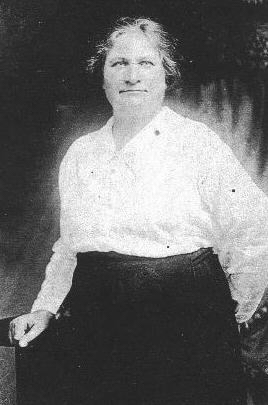
 |
Elisabeth Kraft Lipke
|
FATHER'S name: — Herman, Valentine, or John KRAFT or KREFT
MOTHER'S name: — Anna WEIS
SIBLINGS: — Had at least one sister, named Anna Kraft REXIN
OCCUPATION(S): — Farmer's wife/housewife; in her later widowed years, she worked as a paid companion-housekeeper to another elderly woman
MARRIED: — in a civil ceremony on Saturday, 20 May 1893, in Kreis (District of) Dirschau, Danzig, Germany. ("Certificate of Marriage — Between the worker Johann Lipke living at Czattkau, district Dirschau, and Elisabeth Kreft living at Czattkau, marriage has been made in the presence of the signed registrar; Güttland, May 20th 1893.") Güttland (also sometimes known as Gotland and Coeslin and today bearing the Polish name of Kozliny, 54° 10' north and 18° 48' east) and Czattkau (today called Czatkowy, 54° 8' north and 18° 49' east) were small agricultural villages within the regional jurisdiction of Danzig, a few miles north of the town of Dirschau (see 1882 map), which today is known as Tczew, Poland.
A Catholic wedding service evidently followed the next day. (From the Registry of Marriages from the (Catholic) Parish of Dirschau-Kreisstadt, Altstadt, Westpreussen: 1893, marriage no. 23, May 21st, between Joannes Lipke, engineer, age 26, and Elisabeth Krefft, age 20, from the jurisdiction of Czattkau; Joannes Tormaniko and Franciscus Lipke, witnesses.) [According to the birthyear given above, found in immigration and naturalization documents, Elisabeth's age at the time of their marriage would've been 18 years.]
They had a son, Johann Carl Lipke, who died (age unknown) on 8 February 1897, and possibly another child who died; four other surviving children (see Descendants' Chart) were born to Elisabeth and Johann while they were living in Czattkau where, family stories tell, they worked as farmers, toiling in the fields not far from the west bank of the Vistula River. Their last residence before emigrating was in the village of Brodsack (now Chlebowka, 54° 8' north and 19° 3' east), in the same general region, but east of the Vistula.
EMIGRATED: — In 1904 the family left their homeland for good and (after traveling to Berlin first, according to family lore) they crossed the ocean, departing on the steamship Chemnitz from Bremen around the 16th or 19th of November 1904 and, steaming past the Statue of Liberty, arrived at Ellis Island in the Port of New York around the 2nd of December 1904.
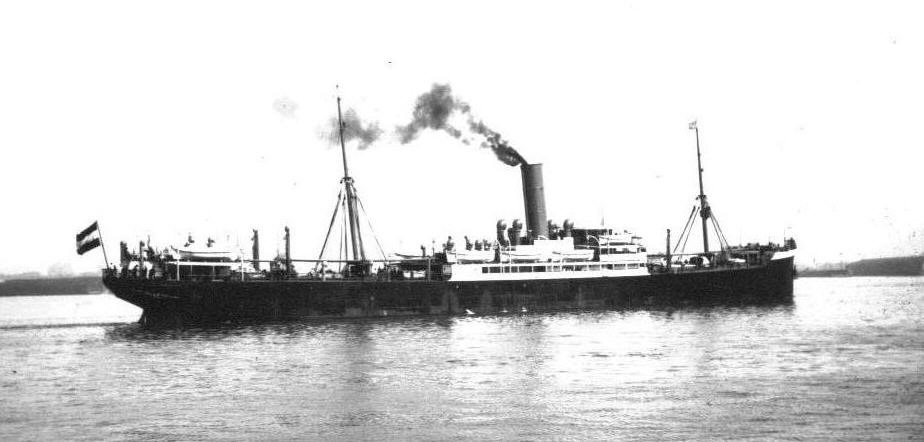 |
The steamship Chemnitz, built in 1901. Photo used with permission from the Steamship Historical Society of America Collection, Langsdale Library, University of Baltimore. |
In this crowd came our ancestors, described on the manifest as: "Johann Lippke," age 37, "laborer;" Elisabeth, his wife, age 29; and children Frank, 10; "Helene," 9; Anna, 8; and "Johann," 6 years old. All except the youngest were able to read and write. They were officially described as Germans who came from Germany, claiming Brodsack as their last residence. They gave their final destination as Syracuse; all had tickets to such final destination; their passage there had been paid for by themselves (it was important for them to say this, since it was illegal by that time for immigrants to have anyone else pay their way); they had $90 in funds with them (this made them significantly more solvent than 90 percent of the rest of the immigrants on board, the average bankroll being around $20, and some had $12, $6, or nothing!). They had never been to the U.S. before, and were going to join Johann's brother in Syracuse, August Lippke, who had immigrated in 1893 and was residing with his own large family of five (soon to be six) young children in a rented house at 213 West Division Street.
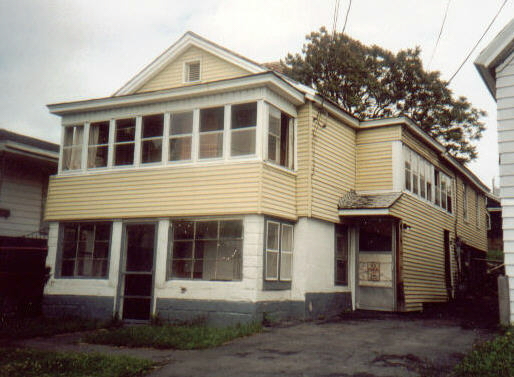 |
716 N. Alvord Street, Syracuse, where the Lipkes were living circa 1906-1907. Photo by Terrie Lipke, June 2001. |
But having been agricultural workers back in Germany, Johann and Elisabeth evidently wanted to return to doing the work they knew best. By 1910 they had moved to their own (mortgaged) farm east of the village of North Syracuse, in the area once known as Taft Settlement (along "Sand Road," according to the census--now near the intersection of Taft Road and Church Street, east of Kreischer Road. This farmland would ultimately be appropriated by the U.S. government for an air base during World War II and is now a northern portion of Hancock International Airport, south of Taft Road).
In June of 1912 their youngest child, Leonard Lipke, was born on the farm. John Lipke worked as a "laborer" in an "iron foundry" in addition to managing the farm; Elisabeth's occupation was "farmer" on the "home farm" [1910 census]. The family, especially Elisabeth, were devout Catholics, and attended Assumption Church on North Salina Street in Syracuse.
NATURALIZED: — In accordance with U.S. law at the time, on 22 April 1916, Elisabeth, as wife, and the minor Lipke children all became United States citizens with their father when Johann Lipke was granted his Certificate of Naturalization (his Declaration of Intention, Petition, and Certificate notation are all filed in the Onondaga County Courthouse in Syracuse). Frank, the oldest child, was over 21 and no longer a minor at that time, and was not listed on the certificate. In a letter from the Onondaga County Clerk's Office regarding "the Petition of Frank Mickels Lipke to be Admitted a Citizen of the United States of America" dated July 3, 1917, his mother was, "[p]ursuant to instructions from Washington," "earnestly requested to call at the County Clerk's Office...and there give testimony for the purpose of establishing the character and residence of the above named petitioner, in the State of New York from the first day of May 1912, to and including the 11th day of November, 1914." I was unable to locate in the Onondaga County Clerk's Office any naturalization papers on Frank, however, so I have not confirmed that his naturalization process was ever completed in this manner. However, I have been told that aliens who fought for the U.S. in WWI received U.S. citizenship, so Frank could have qualified in that way.
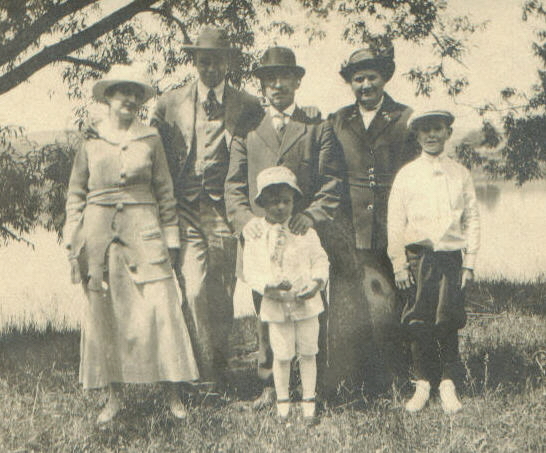 |
Some of the Lipke family, circa 1917: left to right (adults): Helen Lipke Poehlman and her husband, John Poehlman; her parents, John and Elisabeth Kraft Lipke; (children): Leonard and Tony Lipke. |
In January 1926 John Lipke, age 58, died of pneumonia at the family farm after an illness of nine days. He was buried at Assumption Cemetery on Court Street, in Syracuse. In the months that followed his death and burial, Elisabeth, age 50 years when John died, would often visit his grave at the cemetery, where she had a marker placed in his memory. While there she repeatedly met a widower, John N. Denka (also spelled Denke and Dinka), aged about 59, likewise visiting the adjacent grave of his recently-deceased wife, Anna, and likewise a native of the Danzig area.
MARRIED: — On 28 August 1926 Elisabeth (now spelling her name "Elizabeth") Kraft Lipke and John Denka were married at Assumption Church by the Rev. Norbert Scheid O.M.C., and/or Priest Frederick Schraff, with Jacob A. Froehlich and Maria V. Froehlich as witnesses.
A family member, Dorothy Obrist, writes:
"Grandpa Denke was a nice man & he was good to me. I remember him playing the concertina with his beloved parrot, Polly, on his shoulder. The neighbors would come in (after the living room rug was rolled up) & he'd play polkas & everyone danced.... Those were happy times....I do not know when Grandma Lipke married John Denke but it wasn't too long after Grandpa Lipke died. There were some comments made regarding that."
John and Elisabeth lived together at 237 Martin Street in the First Ward of Syracuse, along with Elizabeth's sons Jack and Leonard. It was evidently a happy marriage until John, a machinist in the auto equipment industry, died five years later in May 1930 and was buried beside his first wife.
In later years Elisabeth lived with her youngest son, Leonard, at Ross Park in Syracuse (circa 1937); at 312 Wolf Street in Syracuse with her son Jack and his family (circa 1943-44); and at 1632 W. Onondaga Street in Syracuse (Aug. 1944). At the time of her death she lived at 611 Church Street Extension, just outside North Syracuse, with her son and daughter-in-law, Anthony and Clara Lipke.
DIED: — 7:30 p.m., Tuesday, 25 May 1954 at the age of 79 years, 3 months, 16 days. Place: St. Joseph's Hospital, Syracuse, NY, after a stay of three days. Cause: Stroke; Contributing factor: had had diabetes mellitus for eight years.
BURIAL: — Friday, 28 May 1954, Assumption Cemetery, 2401 Court St., Syracuse, New York, between the graves of her first husband, John Lipke, and their daughter, Anna Lipke Caine.
Elisabeth Kraft Lipke Denka was survived at the time of her death by her sister, Mrs. Anna Rexin, four children, fifteen grandchildren, thirteen great-grandchildren, and several nieces and nephews.
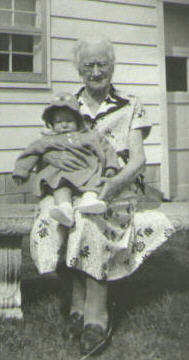 |
"Grandma Lipke" --
|
A family member, Barbara Cook, writes:
"Grandma Lipke was a very devout Catholic. Every morning she caught the bus and went to church. She was a member of the Assumption Church on North Salina Street in Syracuse. You never saw Grandma without her rosaries close by.
"She was a very good cook, she had to be with a family of growing boys. Homemade soups and German potato salad were the best.
"She spent many hours knitting, using hundreds of skeins of yarn in a year. Us kids never ran out of warm mittens and scarfs in the cold Syracuse winters....Her hands literally flew when she picked up her needles. She never dropped a stitch, her knitting was perfection.
"Grandma used to tell...how she took care of her children in 'The Old Country.' She apparently worked in the potato fields on very large farms. (Potatoes were the main crop in Germany during that period.) Mostly the women and their small children worked the fields. She told us, quite proudly, how strong the German women were. When a woman went into labor in the fields she went off to a preferably wooded area, had her baby, wrapped the child in one of her underskirts and went back to the fields, scooped an indent in the soft earth, laid the infant down and continued working.
"Before her children could walk they went to the fields with her. She would dig a small hole, put them in and when necessary she would return and breastfeed them. If a child had colic and cried a lot, she fixed a sugar teat and dipped it in whiskey. She said her babies never cried. We used to tease her and say they couldn't cry because they were drunk. Boy would she get angry and cuss at us in German.
"I'm sure she would agree that her life was easier in the USA.
"When she talked of the trip to the USA she said it was very difficult because they were crowded into a space meant for two....She maintained her heavy German accent and ways, but all of her children were Americanized.
"She was a very proud and dominant personality. In her later years her main health problem was referred to as 'Dropsy.'...Even in her twilight years she was stocky and strong. She would refer to herself as "good German stock."...She had very long hair that she braided and put in a bun. Sometimes when she took it down she would let me brush it for her. Blue eyes and stocky build, around 5'7".
"Very thrifty. She had an old black coat that hung like a potato sack. We tried for several years to
get her to buy a new one but she would always say it was not worn out yet because
it still kept her warm."
| Reference Notes |
| Descendants' Chart |
| Home |